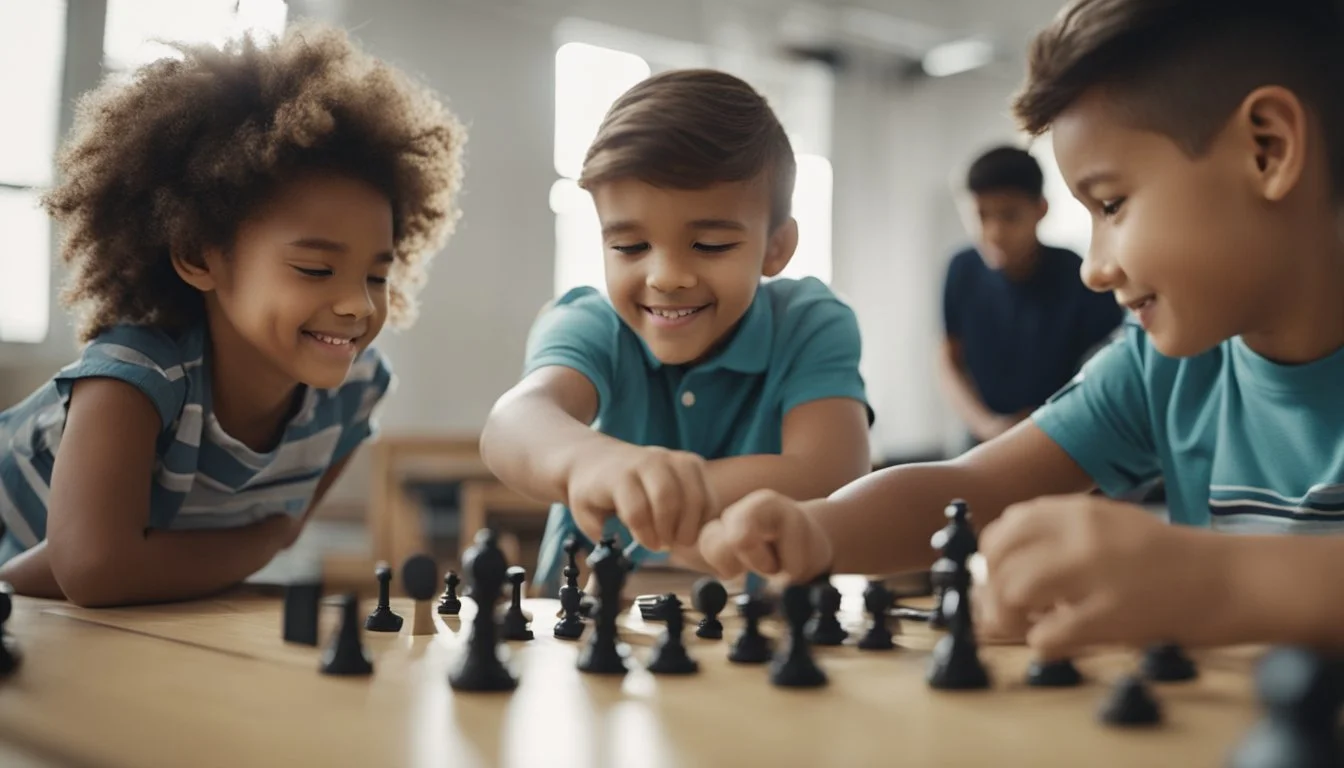11 Tips for Directing Child Actors Like a Pro
Expert Guidance for Success
Directing child actors presents unique challenges and opportunities that can result in standout performances when handled correctly. Understanding the nuances of working with young talent is essential for any director aiming to excel in this area.
What are the most effective strategies to ensure a successful collaboration with child actors? This article provides essential tips and techniques to help directors foster a productive and enjoyable environment for their young stars, ultimately leading to more authentic and engaging performances.
1) Understand Each Child's Unique Strengths
Recognizing the unique strengths of each child actor is crucial. Each child brings a different set of talents and capabilities to the table. Observing how they interact and respond to various situations can provide valuable insights.
Some may exhibit strong emotional intelligence, easily expressing genuine feelings. Others might shine in physical comedy or dramatic roles. Identifying these strengths allows the director to tailor their approach.
Building on a child's natural abilities can boost their confidence. Utilizing techniques like acting workshops or role-playing can enhance these innate skills. Public speaking exercises can further develop their articulation and stage presence.
Mindfulness exercises may help children manage stress and stay focused. Positive reinforcement encourages them to take risks and explore their potential fully. Collaborating with child actors and giving them opportunities to contribute creatively will leverage their strengths effectively.
Even simple actions, like allowing them to clap the slate or look through the viewfinder, can spark excitement. This enthusiasm can translate into more authentic performances. Understanding and nurturing these attributes ensures each child actor performs at their best.
2) Create a Comfortable Environment
Creating a comfortable environment for child actors is essential. When children feel at ease, they perform better. Start by welcoming them warmly and making them feel appreciated.
Take time to get to know each child individually. Learning their likes, dislikes, and concerns helps build trust. Always communicate with kindness and patience.
Ensure the set is child-friendly. This includes safe and quiet rest areas. Keep distractions minimal and provide spaces where they can relax between takes.
Encourage a friendly atmosphere among cast and crew. Positive interactions with adults and other child actors can significantly reduce stress. Foster a sense of camaraderie and support.
Regularly check in with child actors. Ask how they are feeling and if they need anything. Open communication helps alleviate anxiety and builds confidence.
3) Use Age-Appropriate Language
Directing child actors effectively involves using language that is suited to their age and comprehension level. It’s crucial to ensure instructions are clear and simple. Avoid complicated terms or industry jargon that might confuse young performers.
Instead, use straightforward and everyday language. For instance, rather than discussing “emotional range,” try phrases like “show me how happy or sad you are.” This approach helps children grasp what’s expected of them.
Patience is key when explaining scenes or emotions. Sometimes, illustrating through relatable examples or stories will make complex directions more understandable.
Adapting communication based on the child's age can build trust and foster a positive working environment. This can contribute significantly to the child's performance and comfort on set.
Engaging directly with the child actor in a manner they can understand encourages cooperation and minimizes misunderstandings during production.
4) Set Clear and Simple Goals
Directing child actors requires setting clear and simple goals. Children perform best when they understand what is expected of them. Clear instructions help them focus and stay on track.
Use concise language to explain these goals. Avoid complex terminology that may confuse young actors. Break tasks into manageable steps, making it easier for them to follow.
Provide concrete examples. Demonstrating the desired outcome can offer a clearer picture than abstract descriptions. This can help children visualize what they need to achieve.
Positive reinforcement strengthens understanding. Celebrate small successes to encourage confidence. Recognizing their efforts helps maintain enthusiasm and motivation.
Patience is essential. If a child struggles to understand a goal, take a moment to rephrase or simplify it. This ensures they don't feel overwhelmed.
5) "Children are great imitators. So give them something great to imitate." - Anonymous
Children observe and mimic the behaviors around them. Directors working with child actors should exemplify the qualities they want to see in their young performers.
This means demonstrating professionalism and a positive attitude. When directors handle stressful situations calmly, it sets a standard for the child actors.
Maintaining patience is crucial. Children can feel pressured if they sense impatience. By consistently showing understanding and support, directors can help child actors feel more at ease.
Proper preparation is key. When directors are well-prepared, it shows the importance of commitment and diligence. This encourages child actors to approach their roles with a similar dedication.
Giving constructive feedback helps children develop their skills. Directors should highlight what was done well and provide clear, helpful suggestions for improvement.
Leading by example also involves showing respect to everyone on set. This teaches young actors the value of respect and collaboration in a professional environment.
6) Incorporate games and play
Incorporating games and play can significantly enhance a child's performance on set. Using interactive and improvisational drama games helps children relax and become more engaged. One popular game is "Zip Zap Zop," where participants pass energy around the circle. Simple and fun, these games help build focus and spontaneity.
Games can also be used to break up long filming sessions. Children often struggle with maintaining focus for extended periods. Working in 20-minute increments followed by a 10-minute break can keep them fresh. This approach makes the environment playful rather than purely work-oriented, encouraging natural performances.
Another effective game is "Mirror, mirror, on the wall." In this activity, one child acts as the leader while others mimic their actions. This not only hones their observational skills but also deepens their connection to the character they are portraying.
Allowing children to act out scenes with a playful twist can transform the filming process into an enjoyable experience. For instance, asking them to perform a scene as their favorite superhero can trigger enthusiasm and creativity. This technique uses a child's natural inclination to play, making them more invested in their role.
Flexibility is also key. Adapt games based on the child's mood and energy levels. Creativity in choosing or modifying games keeps engagement high, helping them deliver memorable performances.
7) Keep directions concise
Children have shorter attention spans, so it's crucial to keep directions short and to the point. Long-winded explanations can lead to confusion and frustration.
Break down instructions into small, manageable steps. This helps maintain the child's focus and ensures they understand what is being asked of them.
Use simple language that a child can easily grasp. Avoid using complex terminology or jargon that they may find difficult to understand.
Visual aids can be helpful. Sometimes, showing a child what you want them to do is more effective than telling them.
Avoid giving multiple directions at once. Stick to one instruction at a time to avoid overwhelming the child.
Be patient and repeat directions if necessary, but keep them consistent to reinforce understanding.
Encouragement and positive reinforcement can also help maintain their attention and make them feel confident about their performance.
8) Use Positive Reinforcement
Positive reinforcement is crucial when directing child actors. Praise their performance when they deliver a good take. This boosts their confidence and encourages them to put forth their best effort.
Children are particularly responsive to positive feedback. Compliment specific aspects of their performance. This helps them understand what they did well and motivates them to replicate it.
Offer constructive criticism gently. Balance it with praise to keep the child's morale high. This approach leads to a more positive and productive working environment on set.
Engage in small rewards for excellent takes. Simple gestures like a high-five or a small treat can go a long way. This keeps the atmosphere light and enjoyable for the child.
Use encouraging language consistently. Statements like "Great job" or "You nailed it" have a big impact. Maintain a supportive tone throughout the filming process to cultivate a positive experience.
9) Schedule Regular Breaks
Regular breaks are essential when working with child actors. Children have shorter attention spans and can become fatigued quickly. Scheduling breaks every 20-30 minutes can help maintain their energy and focus.
During breaks, ensure the child has time to rest, snack, or engage in light play. This downtime can make the shooting experience more enjoyable and less tiring.
Directors need to be mindful of legal restrictions on work hours for child actors. Breaks are not just beneficial but often required by law. Adhering to these guidelines can prevent overworking and keep the child’s well-being a priority.
Strategically planning breaks can also improve the overall efficiency of the shoot. When children return from breaks, they are likely to be more attentive and perform better. Support from a dedicated child wrangler or set teacher can ensure breaks are effective and timely.
10) Be patient and flexible
Directing child actors requires a significant amount of patience. Children may not always understand directions immediately or may need time to get into character. It’s crucial to work with their pace rather than pushing them too hard.
Flexibility is equally important. Child actors have varying moods, energy levels, and attention spans. Adapting to these fluctuations can help keep the performance natural and genuine.
A director might need to change plans on the spot to accommodate the child's needs. This could mean altering the shooting schedule or modifying scenes to suit the child’s comfort levels.
Being open to improvisation can yield better results. Allow the child some freedom to express themselves and explore the character in their own way.
Patience and flexibility not only help in managing the child's performance but also contribute to a positive and productive set atmosphere. It’s essential to maintain a supportive environment where the child feels safe and encouraged to perform.
11) Encourage Improvisation
Encouraging improvisation can significantly enhance a child actor's performance. Improvisation helps young actors to think on their feet and react naturally in various scenes.
This technique builds confidence as child actors learn to trust their instincts. It leads to more authentic performances, avoiding the stiffness that sometimes comes with strictly memorized lines.
Improvisation allows directors to see the child's unique interpretation of a character or scene. This can offer valuable insights into how to shape their role more effectively.
Short, guided improv exercises can be integrated into rehearsals. These activities can range from simple games to more complex scene work with minimal direction.
Improvisation encourages creativity and spontaneity. These qualities are essential for child actors to bring freshness and originality to their roles.
Including improv sessions also keeps rehearsals engaging. Maintaining enthusiasm and interest is crucial when working with young actors, who may have shorter attention spans.
By fostering a safe environment for experimentation, directors can help child actors feel more at ease. This comfort translates to the screen, bringing a genuine and relatable quality to their performances.
Understanding Child Psychology
Directing child actors requires a deep understanding of their cognitive development stages and emotional sensitivity. These aspects are crucial for creating a supportive and effective environment for young performers.
Cognitive Development Stages
Child actors are at varying cognitive development stages, which affect their ability to understand and interpret scripts. Depending on their age, children may have different levels of comprehension and retention. For instance, younger children might rely more on visual and tangible cues, while older children can handle more abstract concepts.
It is important to tailor instructions to match their cognitive abilities. Simplified language, repetition, and engaging storytelling can help younger actors grasp their roles. Directors should recognize that children's attention spans are shorter than adults, necessitating regular breaks and interactive activities to keep them focused.
Emotional Sensitivity
Children are often more emotionally sensitive than adults, making it vital to handle their emotions with care. Stress, criticism, and high-pressure environments can affect their performance and well-being. Positive reinforcement and constructive feedback are essential for building their confidence.
Directors should be aware of the signs of emotional distress, such as changes in behavior or withdrawal. Creating a supportive atmosphere where children feel safe and valued helps them express their emotions freely and perform better. Utilizing techniques from Social Emotional Learning (SEL) can further aid in developing their emotional intelligence and resilience.
Building Trust with Child Actors
Establishing trust with child actors is fundamental. This involves creating an atmosphere where children feel safe and understood while ensuring clear and open lines of communication to guide their performances effectively.
Creating a Safe Environment
A secure environment is paramount for young actors. To achieve this, directors should take time to get to know the child actors personally before diving into rehearsals. This helps to build rapport and eases any initial anxiety.
Maintaining a structured yet flexible schedule allows children to feel relaxed and prepared. Designated breaks for rest and play can greatly alleviate stress. It's beneficial to involve a Youth Wrangler, a professional who specializes in managing and supporting child actors, ensuring their welfare and focus on set.
Physical safety should also never be compromised. Sets must be child-friendly with all hazards eliminated. Additionally, having a trustworthy adult always present can provide both the child and their guardians with peace of mind.
Establishing Clear Communication
Effective communication with child actors requires patience and clarity. Simplifying complex instructions into bite-sized, understandable chunks can help children grasp their tasks more easily.
Directors should employ positive reinforcement and encouragement to boost the child’s confidence. Phrasing feedback constructively, such as, "That was great! Now let’s try it with a bit more enthusiasm," makes a big difference.
Involving children in the process by asking for their input or feelings about a scene fosters a collaborative atmosphere. Also, non-verbal communication plays a crucial role; maintaining eye contact and a calm tone can reassure and guide a young performer better than words alone.
Parents and guardians should be kept in the loop about expectations and progress, ensuring that everyone is on the same page.
Effective Directing Techniques
Techniques for directing child actors include using positive reinforcement to encourage performance and integrating play into the work process to maintain engagement and enthusiasm.
Using Positive Reinforcement
Positive reinforcement is a powerful tool when directing child actors. It includes praising specific behaviors or performance aspects, such as saying, "You did a fantastic job remembering your lines!" Specific praise helps children understand what they did right and encourages them to continue the behavior.
Using a reward system can also be effective. Small rewards like stickers or extra playtime can motivate children and make them feel appreciated. It's crucial to balance positive reinforcement with genuine feedback. Ensure that praise is sincere and not overused, as children can recognize insincerity.
Incorporating Play Into Work
Incorporating play into the work process can transform the set environment for child actors. This strategy involves making activities feel more like games rather than rigid tasks. For example, directors can turn rehearsals into fun, engaging exercises, such as role-playing games or improvisation activities.
Managing shooting schedules is another aspect. Working in short increments, like 20 minutes of shooting followed by a 10-minute break, helps maintain children's attention and energy levels. Breaks can include playtime to let the children relax and recharge.
Integrating play into directing not only keeps the child actors engaged but also fosters creativity and natural performances.










